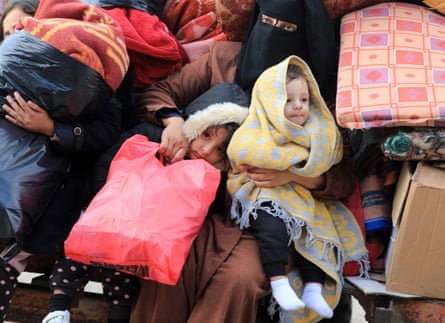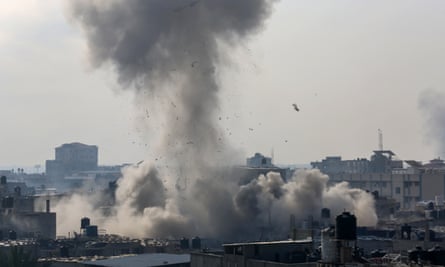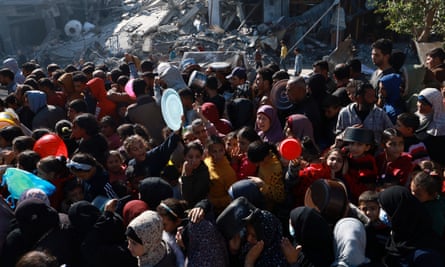‘We are abandoned’: Ceasefire made little difference to displaced in Gaza
It took only seconds for the bombs to start falling on Gaza again. The week-long ceasefire ended at 7am local time, and almost immediately the sound of explosions filled the corridors of al-Nasr hospital in the south of the territory.
By mid-morning, 32 people were dead and the already crowded wards of Gaza’s remaining hospitals were struggling with a new influx of patients, according to local reports.
“This is the biggest still functioning hospital in Gaza. It’s at 200%-plus capacity,” said James Elder, a spokesperson for Unicef, in a video on X. “The health system is overwhelmed, it cannot take more children with the wounds of war.”
He spoke from a room crammed with children; families seeking treatment for injuries or the infectious diseases that are spreading fast, mixed together in hospitals with those seeking shelter from the gathering cold.
Nowhere feels safe from bombs, he added, as he described the rapid resumption of hostilities; one had already landed just a few dozen meters away from the hospital.
The people of Gaza know what is coming, after seven weeks of intense bombardment and a ground invasion in the north that killed more than 15,000 people, over two-thirds of them women and children.

The US secretary of state, Antony Blinken, has said Israel must do more to protect civilians as it starts targeting Gaza again. But many on the ground, or working to support civilians there, fear an even greater catastrophe is looming.
The fresh waves of attacks hit a population physically weakened by weeks without access to adequate food, clean water or sanitation, traumatised by the damage of the war, and largely displaced from their homes. Nearly 80% of Gaza’s population are now internal refugees.
Aid agencies have warned that even increased food and medical shipments during the ceasefire were a “trickle” that did not meet basic triage needs of people in Gaza.
“We are abandoned,” said an administrator in a UN-run shelter in a vocational training centre in southern Khan Younis, who asked for anonymity as he was not authorised to talk to the media. The week-long ceasefire had made little difference to conditions for the displaced, who are living off flour and tinned tuna or beans distributed by the UN.
“We can hear the bombing now and a lot of people are very worried. They are just thinking about survival from day to day. Everybody has lost their homes or many relatives or both. We cannot think of anything any more.”

Fresh orders from Israel to evacuate areas in the south that had been declared safe have added to fears about what the coming days and weeks will bring.
“There are 6,500 families here in this shelter and we are not from round here. We have all come from the north already and have no homes. No one has anywhere to go,” said another administrator.
“There is no place for people even in the streets. The hospitals are totally overrun. There is nothing in the market to buy to eat and now it is cold at night too and the children are suffering badly. People are cutting down electricity poles to get wood for fires to keep warm. So where do we go in these conditions?”
Israel has said it will keep fighting until it has destroyed Hamas, after the 7 October attacks in which 1,200 people were killed, most of them civilians.
The military announced on Friday morning that it was dividing the entirety of Gaza into dozens of numbered blocks as a prelude, it said, to demanding targeted local evacuations in the crowded south of the strip ahead of planned bombing.
It dropped leaflets over Gaza on Friday with a QR code to a website with a map of all the areas and geolocating people within them. Fuel supplies mean limited access to electricity or internet for many people, but even those who can get online may struggle to follow these orders.
Gaza was densely populated before the current war began, and most of its population is crammed into the southern half of the strip, struggling to survive first under weeks of siege and under a tight blockade.
Trying to corral civilians into ever smaller areas could have devastating consequences. “There is fundamentally nowhere for people to go,” said Danila Aizi, the Palestine country manager for the charity Humanity and Inclusion.
For now, life has returned to the grim daily rhythm of queueing for everything from food, water and toilets to a chance to power mobile phones, and waiting for attacks.

Targets on Friday included a large building in Khan Younis, and nearby a single apartment in Hamad City, a Qatari-funded housing development, the AP reported. There were also strikes on a home near Gaza city, and in the refugee camp of Maghazi in central Gaza, AP reported.
Amal Abu Dagga was taken to the al-Nasr hospital after her home was hit, where she sat covered in blood, weeping for her family. “I don’t even know what happened to my children,” she said.
After a week’s break from treating new war injuries, doctors in Gaza have prepared for another wave of patients on their already crowded wards.
“We have put all our scheduled cases on hold and are waiting for the casualties,” said Paul Ley, an orthopaedic surgeon with the International Committees of the Red Cross (ICRC), who is working at the hospital.
“We are already overwhelmed. There are something like 2,000 patients in a hospital built for 300, and over half need surgery. But we don’t have enough drugs, and insufficient anaesthetics,” said Ley, who has been performing four to five amputations at the hospital every day for weeks.
“There is very little pain control and we have to use techniques that have been abandoned for many years because they are seen as dangerous.”